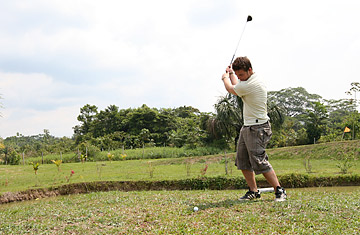
An intrepid duffer tees off at Peru's Amazon Golf Course
Golf generally isn't considered an extreme sport. But that's because Peru's Amazon Golf Course is not on any professional or amateur tour schedule. Not yet, anyway.
The Amazon Golf Course just might be the world's most remote links. Getting to it means first getting to Iquitos, a bustling Peruvian city of about 450,000 on the banks of the Amazon River. This is not the easiest thing. Iquitos is now the world's largest city that is accessible only by air or boat.
The golf course is another thing altogether. Peru is not a big golfing country, and the sport is virtually unknown in the jungle, making it all the more difficult to give directions to a cab driver in Iquitos. And there aren't really any cabs. The course is located down an unmarked, pitted dirt road; instructions and a map provided by management tell golfers to take a "moto-kar" — a euphemism for the ubiquitous motorized rickshaws that ply Peru's jungle town — about 45 minutes out of town. A sign announcing the course entrance appears about a half a mile down a road with organ-shifting bumps.
Though lacking a clubhouse and other amenities associated with golfing, the course at first glance appears like any other. The par-33 nine holes cover 24 acres (10 hectares) of grass; the greens are surrounded by the mandatory hazards. However, things change once the game is under way.
The water traps are populated with piranhas; caimans (reptiles much like crocodiles though slightly smaller) tend to meander onto the course and sun themselves in the sand traps; the occasional red-tailed boa constrictor has been chased off by the grounds crew. There are rumors that one golfer lost a finger to piranhas while trying to retrieve a ball, but that could be a golfing twist to an age-old jungle myth. Iquitos is full of stories of a friend of a friend knowing someone who lost a body part to a toothy fish or was swallowed up by a big snake.
The course owners take no chances, though. "We are the only golf course in the world where a machete is standard issue with clubs," says manager Bill Grimes, 63, a transplant from Crawfordsville, Ind. Grimes got involved in the golf-course project one night in 2004, shortly after he left behind his Indiana soybean farm to live in Iquitos full time. He had been talking to his friend Mike Collis, whom Grimes had met during his first trip to Iquitos. "I was watching Living Golf on CNN," says Collis, a British expat who moved to the town 12 years ago, "and suddenly it dawned on me. I jumped up and said we should have ourselves a golf course in Iquitos." The two became the first of 60 investors to put up seed capital to buy an abandoned cattle ranch, which they turned into the first Amazon golf course. The course was finished a few years later; the first official tee-off came in 2008.
Owning a golf course is one thing. Grimes doesn't play the sport at all, yet he is now manager. After nightly powwows over drinks on the boardwalk overlooking the Amazon River, Collis finally got Grimes to grudgingly agree to act as course manager last year. Grimes does that in addition to his regular work — operating a restaurant and a tour company that offers customized cruises down the Amazon. He wants to turn Amazon Golf into a first-class establishment, though he knows it will be an enormous amount of work bringing it up to par with the country club in his hometown, with its clubhouse, banquet halls, swimming pools and entertainment in addition to lush rolling greens.
The Amazon Golf Course has none of this, but a restaurant down the road does serve up paiche, a prehistoric fish that can grow up to 10 ft. (3 m) long and weighs nearly half a ton (450 kg). It is endangered in the wild, but fish farming keeps it on the menu. Grimes says golfers who tee off early enough on Saturdays can saunter down to the restaurant and ask the owner to harpoon a paiche for lunch.
Grimes has spent the past year planting nearly 2,000 trees and finding ways to keep the jungle vegetation from growing out of control. To do this, he has a three-man grounds crew equipped with one push mower, two weed whackers and a hand-pushed, sand-filled roller that requires at least two people to maneuver. There is a plan to buy a sit-down lawnmower, but the logistics of getting it from the U.S. to the deep jungle are not simple. "Most golf courses need an irrigation system to keep things green. We have the opposite problem. We have to drain the course from being perpetually soggy," he says. Iquitos receives an average of 110 in. (280 cm) of rain annually, making it one of the wettest spots in Peru.
The biggest challenge is getting the intrepid tourists visiting Iquitos and the local population interested in golf. There were eight golfers in June, all tourists. A special offer of three rounds of golf free to Peruvians under age 25 has yet to entice anyone. Peruvians prefer the small soccer pitch in front of the driving range. "We get a lot of people on the weekends, but they come to play soccer. Everyone loves soccer," says Cesar Diaz, 20, who is in charge of renting clubs. Diaz is also the chief caddy. O.K. — he is the only caddy; given his many hours of free time, he spends hours on the driving range. "I think golf is great. I have a lot of fun, but the neighbors think it is kind of strange to stand around hitting a little ball."
